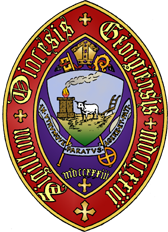Though the practice has been done away with a century ago, pew rents were once the primary source of funds for Episcopal Churches. Prominent families rented prominent pew, so that the closer a family sat to the altar or pulpit, it signaled their higher socio-economic position. Some churches would rent all the pews. Others would have some pews “set aside for strangers” as Christ Church in Macon put it in a vestry vote in 1833.
 This system assisted in building churches. For example, an auction for pews in Columbus raised a revenue of $3,369 a year in 1835, making the construction possible (this is $105,855 in 2022 dollars). Yet the system was not never perfect. The Panic of 1837 was devastating to the economy. By October, 1839, creditors filed suit against the church for failing to make its payments as pew rents fell to less than $1,000 a year in 1839-1840.
This system assisted in building churches. For example, an auction for pews in Columbus raised a revenue of $3,369 a year in 1835, making the construction possible (this is $105,855 in 2022 dollars). Yet the system was not never perfect. The Panic of 1837 was devastating to the economy. By October, 1839, creditors filed suit against the church for failing to make its payments as pew rents fell to less than $1,000 a year in 1839-1840.
While pew rentals funded the ministry, they were also a deterrent to any visitors and especially the poor. In the 1850s, St. Paul the Apostle in Savannah and the Church of the Atonement in Augusta were the first churches in the Diocese to offer free pews.
St. Paul’s in Savannah would be the first. The legacy of Mrs. Dorothy Abrahams of Savannah, and the generosity of the parishioners of Christ Church and St. John’s Church assisted in paying for a chapel to be built with an accumulated sum of $15,000. This built St. Paul’s Free Chapel, a congregation inspired by the Oxford Movement vision that all sorts and conditions of men, women and children are part of the Body of Christ and the church was not a place where the world’s measures applied. For the first time in Savannah, an Episcopal church was to be supported by the contributions rather than from the rental of pews.
A further step toward democratization of the Episcopal Church in Georgia occurred shortly after in Augusta when the Church of the Atonement was founded. A fund established by Mr. and Mrs. Hallowell Gardiner and Miss Mary G. Jones made possible a church to serve the families in a new manufacturing area.
 Bishop Stephen Elliott had mentioned the obstacle pew rents presented in some of his Bishop Addresses. For example, in 1854 he said, “To be pointed at as the church of the rich and the refined and the fashionable, when Christ had given it as one of the marks of his mission, that the gospel was preached unto the poor, was a condition under which she was not satisfied to rest.”
Bishop Stephen Elliott had mentioned the obstacle pew rents presented in some of his Bishop Addresses. For example, in 1854 he said, “To be pointed at as the church of the rich and the refined and the fashionable, when Christ had given it as one of the marks of his mission, that the gospel was preached unto the poor, was a condition under which she was not satisfied to rest.”
Yet pew rents remained the norm. This changed slowly with the practice finally ending on December 31, 1919 when Christ Church in Savannah, the final congregation with pew rent, removed its rental system. Through its history, the principal source of income for the parish had been the rental of pews, which in 1910 brought in $8,144, ($250,588 today). Annual pledges became the new normal for churches that had been unsure how to budget as they dropped the requirement to rent their pew.
Pictured: Trinity Church in Columbus and Christ Church in Savannah.
